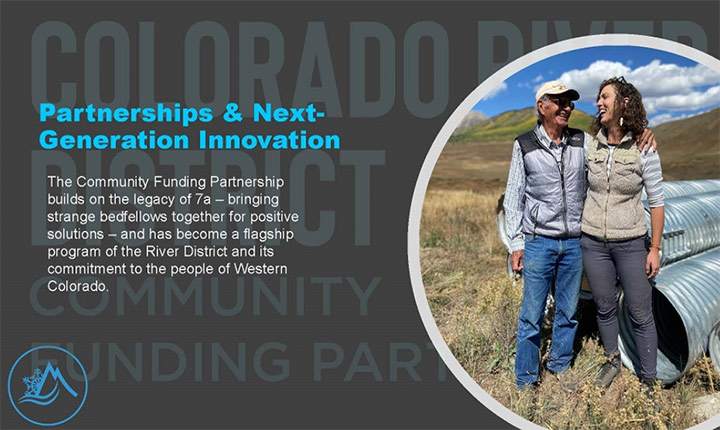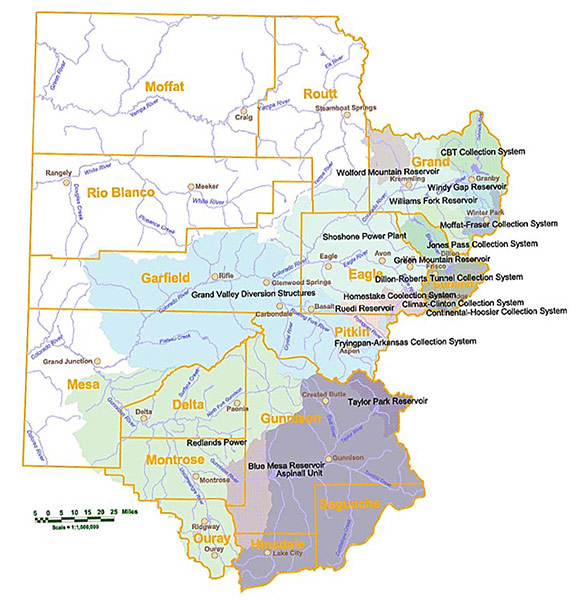When the Colorado River District was established in 1937, its founders grappled with a straightforward issue: how to keep water flowing west. Though today’s core mission remains the same, Colorado’s skyrocketing population and plummeting water levels add major complexities to navigating and communicating a new generation of water challenges…
— from an article, ‘New Messaging for the Next Era in Water’, posted to the Colorado River District website on February 22, 2022.
As hinted in the Colorado River District (CRD) article linked above, the 1922 Colorado River Compact demanded that the state of Colorado — and the rest of the Upper Basin states feeding tributaries into the Colorado River — “keep the water flowing west”, to California, Arizona and Nevada. The promise was to deliver 7.5 million acre feet annually, on average, downstream.
That was in 1922.
We’re celebrating the 100th anniversary of that Compact, this year. But maybe ‘celebrating’ isn’t quite the right word?
A good deal of our Colorado ‘water news’ has focused, lately, on seemingly intractable problems, based on that 100-year-old promise. That is to say, much of the news has tended towards doom and gloom.
From the linked CRD article:
The doomsday parade on the news and social media leaves many in our communities fearful, frustrated, or numb to act. But our new generation of problems comes with a new generation of innovative solutions. The River District is proud to offer up our Community Funding Partnership as one model. Already making waves after just one year of funding, the unique grant program is helping to tackle big water issues with local, multi-benefit projects. As the voice of the River District, the [External Affairs] Team will ensure this unique program reaches all corners of our West Slope boundaries and those who need it most…
The following graphic was used to illustrate the article.
The caption reads:
The Community Funding Partnership builds on the legacy of 7a — bringing strange bedfellows together for positive solutions — and has become a flagship program of the River District and its commitment to the people of Western Colorado.
In the graphic, we see two people — the strange bedfellows?
I’m guessing the guy is supposed to represent the agricultural community, judging by his jeans and vest and baseball cap. (Thankfully, not a MAGA baseball cap. That would make things awkward.)
The gal is clearly an environmentalist. You can just tell.
But they are friends, nevertheless. They want to cooperate. They’re laughing about the uncomfortable fix we’re in, and are ready get to work laying culverts to solve the problem.
The caption also mentions “7a” — also known as Proposition 7A — which doubled the property tax mill levy in 2020 for residents living within the Colorado River District. Archuleta County is not within that district. It stretches from Routt and Moffit Counties in the north, to Ouray and Hinsdale Counties in the south.
Following voter approval of Proposition 7A, the average residential property is now paying an additional $7 a year to fund CRD projects.
Those projects apparently include a “new Strategic Communications Plan”.
Presenting to the newly appointed Information & Outreach Committee at the Board’s Special Joint Meeting in February, the EA Team shared key elements of a new Strategic Communications Plan. While the primary goal for River District outreach remains “to ensure water security for our constituents,” water struggles continue to grow east of the Divide and across the seven Colorado River Basin states – struggles which greatly impact West Slope water users. River District communications must therefore provide water education to those outside our borders, as well as continue to offer guidance and leadership for interstate negotiations on behalf of Colorado’s water across the Southwest.
We, here in Pagosa, are “outside” the CRD borders, but the newly appointed Information & Outreach Committee and the External Affairs Team apparently intends to provide us with water education.
Communication is, of course, a double edged sword. If the communication managers are spreading misinformation, that can actually lead to harmful outcomes.
Last November, President Biden signed the bipartisan Infrastructure Investment and Jobs Act (IIJA)… which earmarked $8 billion for “Western water infrastructure maintenance and projects” – repairing aging dams and canals, building new storage and conveyance facilities, funding water conservation and recycling projects, and improving watershed and ecosystem management.
Sounds like a lot of money. But, as far as I can tell, it’s all earmarked for the federal Bureau of Reclamation — the folks partly responsible for the water mess we’re currently in. Will they be digging our deferred maintenance hole even deeper than it is already? That will depend on how much is spent on “new facilities” and how much is spent on “repairing.” Government is awfully good at “new facilities”; not so good at “repairing”.
But all is not doom and gloom.
The San Juan Water Conservancy District (SJWCD), supported by our tax dollars here in Archuleta County, held their bi-monthly regular board meeting on Monday, and voted to proceed with their own, local “Strategic Communications Plan”.
(Disclosure: I serve as a volunteer on the Conservancy District board of directors, but this editorial expresses my own opinions, which are not necessarily the opinions of the board as a whole.)
SJWCD adopted a Strategic Plan last year, (which you can access here), focused on five key goals:
- Determining the water needs (agricultural, municipal, environmental, and recreational) of the District, and how the San Juan River Headwaters Project and other projects might meet those needs.
- Education of the community at large regarding critical water issues that face the District, the Southwest Basin of Colorado, and the Colorado River Basin and its tributaries.
- Conservation of our limited water resources through continued existing programs and initiation of new programs.
- Ensuring the financial health and viability of the District through cost-effective asset management including, but not limited to the District’s water rights and collaboration with existing and new partners.
- Establish a reputation of operational excellence through communication both internally and externally with partners and the general public.
The “San Juan River Headwaters Project” is a moniker adopted by SJWCD, shortly before the district approached the voters in 2017, asking for a mill levy increase that would triple the amount of money the Conservancy District could spend each year. (The voters overwhelmingly rejected the proposed increase.)
The real name of the project, however, on all pertinent legal documents, remains the same. “Dry Gulch”.


